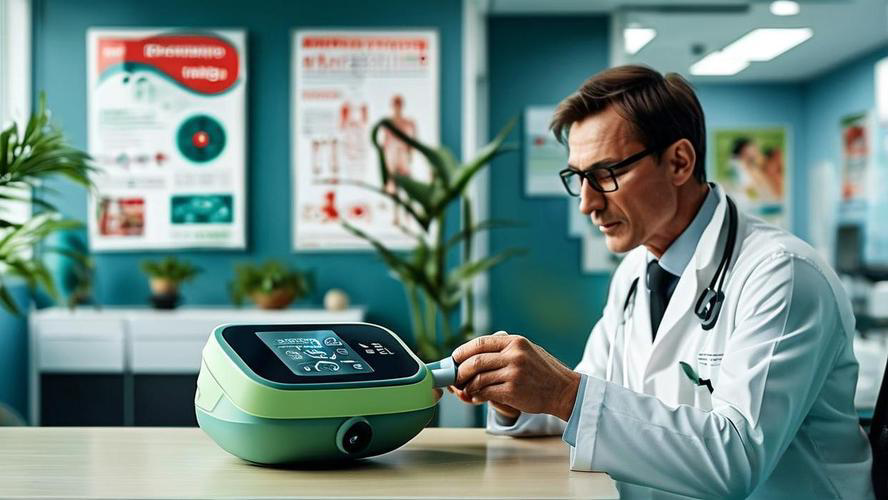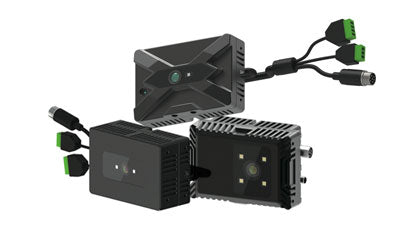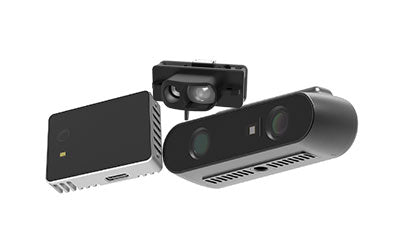ToF Sensors in HealthTech: Non-Contact Monitoring & Medical Insights

How Can ToF Sensors Improve Home Health Monitoring and Medical Imaging?
The Rise of ToF Sensors in Health Technology and Medical Imaging
With the growing demand for health monitoring and medical technology, traditional contact-based measurement and 2D imaging systems are no longer sufficient to meet the modern requirements for non-contact and real-time sensing in healthcare and home health management. TOF (Time-of-Flight) sensors, known for their high-precision 3D depth perception, low power consumption, and real-time responsiveness, are rapidly emerging as a key enabling technology in both medical imaging and health technology.
What Is the Use of Health Technology?
The purpose of health technology is mainly to enhance medical efficiency, improve health management, and strengthen public health services. Its applications include:
-
Disease Prevention and Early Diagnosis
Health technology utilizes wearable devices, smart sensors, and mobile health applications (mHealth) to continuously monitor key health indicators such as blood pressure, glucose, heart rate, and sleep quality. This allows users to detect potential health issues early and take preventive measures. -
Medical Diagnosis and Treatment Assistance
Technologies like medical imaging, telemedicine, and AI-assisted diagnosis help doctors achieve higher diagnostic accuracy, shorten examination time, and develop personalized treatment plans. -
Remote Health Management and Rehabilitation
Through remote monitoring and data analytics, health technology enables chronic disease management, rehabilitation guidance, and telemedicine, allowing patients to receive professional care at home. -
Improving Medical Resource Efficiency
Health technology optimizes hospital operations, reduces waiting time, and improves medical equipment utilization. Digital record systems and intelligent scheduling enhance overall efficiency and coordination. -
Promoting Public Health and Decision-Making
Big data, the Internet of Things (IoT), and health information systems are used to monitor population health trends, predict epidemics, and guide vaccine distribution and public health strategies.
In essence, health technology aims to prevent diseases, enhance medical efficiency, and improve both personal and public health, transforming healthcare from passive treatment to proactive health management.
I. The Growing Demand for Non-Contact and Real-Time Sensing in Healthcare
In modern hospitals, rehabilitation centers, and home healthcare environments, the demand for non-contact and real-time sensing is increasing. Traditional contact-based methods not only cause patient discomfort but also pose cross-infection risks. Meanwhile, 2D cameras or infrared thermometers face limitations in precision, responsiveness, and adaptability in complex environments.
-
Surgical Assistance: During surgery, precise 3D positioning of instruments and patient anatomy is essential. ToF sensors can capture spatial depth data in real time, providing accurate navigation for minimally invasive surgery and helping surgeons operate more safely and precisely.
-
Rehabilitation Monitoring: Continuous recording and angle evaluation of limb movements are vital in rehabilitation training. ToF sensors enable real-time motion tracking and dynamic analysis, allowing therapists to quantify progress and optimize treatment plans.
-
Respiration and Heart Rate Monitoring: Non-contact sensing captures subtle body movements and breathing patterns without physical disturbance. Combined with AI algorithms, ToF systems provide real-time breathing rhythm and heart rate analysis, ideal for sleep monitoring, chronic disease management, and respiratory condition detection.
-
Non-Contact Temperature Measurement: During pandemic prevention and daily health checks, non-contact temperature detection is crucial. By combining depth sensing with infrared thermography, ToF sensors enable fast, accurate, and low-error temperature measurement, suitable for hospitals, schools, public areas, and smart home devices.
Compared with traditional systems, ToF-based medical applications provide high-precision 3D depth perception, millisecond-level responsiveness, and low power consumption. This technology not only improves the efficiency of surgical assistance, rehabilitation, and health monitoring but also lays the foundation for the future of Health IoT, remote healthcare, and personalized health management.
II. Applications of ToF Sensors in Surgery, Rehabilitation, and Health Monitoring
With the digital transformation of healthcare, ToF (Time-of-Flight) sensors have become increasingly vital in medical and health monitoring. Their applications span surgical assistance, rehabilitation training, respiratory tracking, and non-contact temperature measurement. Thanks to their precise 3D depth perception, real-time performance, and energy efficiency, ToF sensors are becoming a cornerstone of next-generation medical imaging and health IoT devices.
-
Surgical Assistance
ToF sensors can generate real-time 3D models of the surgical field, accurately capturing the spatial positions of surgeons, instruments, and patients. Combined with AI image analysis and surgical navigation systems, ToF enables:-
Path planning and precision guidance, reducing surgical errors;
-
Enhanced precision for minimally invasive surgeries, minimizing incisions and bleeding;
-
Real-time visualization and data recording for postoperative review and training.
This real-time depth perception technology is especially useful in neurosurgery, orthopedics, and laparoscopic procedures, forming a crucial part of the intelligent operating room.
-
-
Rehabilitation Monitoring
In physical therapy and rehabilitation, ToF sensors continuously track limb movements—joint angles, range of motion, gait, and coordination. Their applications include:-
Automatically generating rehabilitation reports with objective, quantifiable data;
-
Providing real-time motion feedback to ensure correct posture and prevent injury;
-
Enabling remote rehabilitation and telehealth.
With AI integration, ToF sensors support intelligent rehabilitation evaluation and personalized therapy optimization, improving treatment outcomes.
-
-
Respiratory Motion Detection
ToF sensors detect chest and abdominal movement for breathing pattern analysis—ideal for sleep studies, early respiratory disease detection, and chronic care. Compared with contact-based devices, ToF offers:-
True non-contact monitoring for greater comfort;
-
Real-time capture of breathing rate, depth, and irregularities;
-
AI-driven alerts for conditions like apnea, asthma attacks, or irregular heartbeats.
This technology has wide applications in hospitals, smart beds, and home health IoT devices.
-
-
Non-Contact Temperature Measurement
Using 3D depth sensing, ToF sensors can accurately identify the forehead or facial area for fast, accurate, and touch-free temperature screening. Benefits include:-
Eliminating errors caused by angle or lighting conditions;
-
Integration into hospitals, workplaces, airports, and smart home systems for large-scale monitoring;
-
AI-powered alerts for abnormal temperature detection—essential for epidemic control and health tracking.
This application is quickly becoming a standard in home health IoT and intelligent medical devices.
-
With their high-precision depth sensing, millisecond-level response, and low power consumption, ToF sensors are transforming surgery, rehabilitation, respiratory tracking, and temperature monitoring. As AI algorithms advance and IoT ecosystems expand, ToF technology is poised to become a standardized solution for smart health and medical imaging—empowering the next generation of remote healthcare, home health management, and personalized medical services.
III. Technical Advantages: Real-Time Performance, Depth Sensing, and Low Power Consumption
In the field of medical and health technology, ToF (Time-of-Flight) sensors are rapidly becoming the core sensing solution for surgical navigation, rehabilitation monitoring, respiratory motion detection, and home Health IoT devices, thanks to their unique technical advantages. These advantages can be summarized as follows:
-
Millisecond-Level Real-Time Performance
ToF sensors can capture depth data within milliseconds, enabling instant and continuous 3D spatial perception.-
In operating rooms, real-time tracking of surgeons and surgical tools reduces the risk of errors and improves surgical safety.
-
In rehabilitation monitoring, patient limb movements can be captured and analyzed in real time, helping therapists adjust training plans.
-
In respiratory and heart rate monitoring, real-time data allows for early detection of abnormal breathing patterns or heart rate changes, supporting early intervention and intelligent health management.
This high responsiveness makes ToF technology an ideal choice for medical digitization, remote monitoring, and smart health devices.
-
-
High-Precision Depth Sensing
ToF sensors can detect spatial variations at the millimeter level, providing accurate 3D depth information.-
In minimally invasive surgery, they precisely locate surgical regions and instrument paths, assisting navigation systems for more accurate operations.
-
In rehabilitation, they quantify joint angles, gait, and limb movements, providing data support for personalized recovery programs.
-
In home health monitoring, depth data analysis can assess posture, breathing rhythm, and activity levels, enabling more refined health management.
This high precision not only improves the reliability of medical operations but also provides a scientific foundation for health technology devices.
-
-
Low Power Consumption and Wearable Integration
ToF sensors are energy-efficient, making them ideal for long-term continuous monitoring and easy integration into wearables, home Health IoT terminals, and smart medical devices.-
In wearable rehabilitation devices, low power consumption extends battery life and enhances usability.
-
In home Health IoT systems, ToF sensors can be integrated with smart beds, furniture, and health monitors to enable all-day, contactless health tracking.
-
In hospitals and clinics, low-power sensors reduce energy consumption and heat buildup, ensuring stable long-term operation.
-
By combining real-time responsiveness, high-precision depth sensing, and low power consumption, ToF sensors enhance the safety and efficiency of surgical navigation and rehabilitation while offering reliable technological support for Health IoT, telemedicine, and personalized healthcare. With algorithmic advancements and decreasing sensor costs, ToF technology is expected to become a standardized solution in smart health technology and medical imaging, providing a strong foundation for smart healthcare, remote monitoring, and digital health ecosystems.
IV. Medical Regulations and Technical Challenges
Despite its promising potential, ToF technology still faces several challenges in medical and health applications:
-
Strict Regulatory Requirements: Compliance with certifications such as FDA and CE demands high standards for accuracy, stability, and safety.
-
High Accuracy Demands: Millimeter-level precision is critical—any deviation in surgical navigation or rehabilitation tracking can affect treatment outcomes.
-
Human Safety Standards: Infrared light intensity must comply with safety regulations to prevent long-term exposure risks.
-
Environmental Adaptability: Factors like strong lighting, reflective surfaces, or clothing can affect accuracy, requiring algorithm optimization and multi-sensor fusion.
V. Recommendations for MedTech Manufacturers and Health App Developers
-
Scenario-Oriented Product Design
Design ToF solutions tailored to specific scenarios—such as surgical rooms, rehabilitation centers, or home Health IoT—by selecting the right resolution, range, and sampling rate. -
Emphasize Data Security and Privacy
Encrypt and anonymize depth data to comply with privacy and medical data protection regulations. -
Integrate AI and Cloud/Edge Computing
Use AI algorithms for real-time ToF data analysis. Edge computing minimizes latency, while cloud storage supports long-term health data management. -
Standardization and Interoperability
Follow medical device interface standards to ensure seamless integration between ToF sensors, electronic health records, mobile apps, and wearable devices.
VI. Future Outlook: Building the Health IoT + ToF Ecosystem
With the rapid development of HealthTech and smart home technologies, ToF sensors are set to play a central role in home health management and the Health IoT ecosystem—extending healthcare beyond hospitals and enabling 24/7, contactless, and holistic health monitoring.
-
Smart Home Health Monitoring
Leveraging ToF’s real-time 3D sensing, smart home systems can accurately monitor the activity and health of all family members:-
For seniors: Detect movement patterns, falls, and sleep posture to provide early warnings and remote care support.
-
For children: Track activity levels, breathing rhythm, and behavioral patterns for health and growth assessment.
-
ToF data can synchronize with smart appliances, beds, and wearables for full-house health monitoring and automated smart-home responses.
-
-
Remote Healthcare and Rehabilitation Guidance
By combining ToF sensors with video communication, AI analytics, and depth data processing, remote medical care and rehabilitation become more accurate and accessible:-
Doctors can remotely observe and guide rehabilitation exercises in real time.
-
For chronic disease or postoperative patients, continuous monitoring enables early detection and intervention.
-
This model reduces hospital visits and costs while expanding access to medical care in remote areas.
-
-
AI Health Assistant and Personalized Health Analytics
Integrating ToF depth data with AI enables personalized health reports:-
Visualize daily activity, breathing patterns, sleep quality, and temperature variations.
-
Provide customized exercise plans, rehabilitation routines, and lifestyle recommendations based on health goals.
-
Support smart reminders and health alerts within the Health IoT ecosystem, achieving data-driven health management.
-
-
Building the Health IoT + ToF Ecosystem
With advancements in 5G, edge computing, and AI, ToF sensors will integrate deeply with smart home devices, wearables, and health apps to:-
Create an always-on health monitoring network with real-time data capture and analysis;
-
Support remote medical consultations, rehabilitation, and personalized care;
-
Establish a closed-loop health management system covering data collection, analysis, feedback, and intervention.
-
The Health IoT + ToF ecosystem enhances the precision and efficiency of home health management while laying the technological foundation for future smart healthcare, digital health, and health data analytics. As ToF sensors become more affordable and algorithms improve, home healthcare will evolve from passive monitoring to proactive prevention, real-time intervention, and personalized health optimization, realizing a truly intelligent and healthy lifestyle.
Conclusion
From surgical assistance to rehabilitation monitoring, and from respiratory tracking to contactless temperature measurement, ToF sensors are rapidly emerging as a key enabler in health technology and medical imaging. With continued improvements in algorithms, cost reduction, and the rise of the Health IoT ecosystem, ToF technology will further accelerate the digital and personalized transformation of modern healthcare.
Synexens 3D Of RGBD ToF Depth Sensor_CS30
Our professional technical team specializing in 3D camera ranging is ready to assist you at any time. Whether you encounter any issues with your TOF camera after purchase or need clarification on TOF technology, feel free to contact us anytime. We are committed to providing high-quality technical after-sales service and user experience, ensuring your peace of mind in both shopping and using our products.
-
Postado em
CS30





